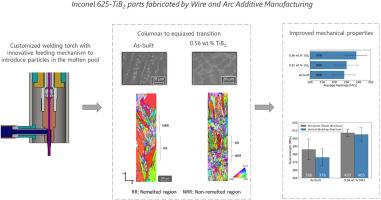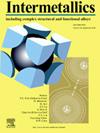Grain refinement of Inconel 625 during wire-based directed energy deposition additive manufacturing by in-situ added TiB2 particles: Process development, microstructure evolution and mechanical characterization
IF 4.3
2区 材料科学
Q2 CHEMISTRY, PHYSICAL
引用次数: 0
Abstract
In this study, a novel method for enhancing the quality of components fabricated by wire and arc additive manufacturing (WAAM) was developed. This approach employs an innovative mechanism featuring an actuator that dispenses a solution containing refinement particles (TiB2 inoculants), in conjunction with a soldering flux that vaporizes prior to reaching the electric arc. This leaves the particles to adhere to the welding wire or be carried by the shielding gas. By implementing this device, TiB2 particles were successfully incorporated into the molten pool during the WAAM process of Inconel 625 at levels of 0.31 and 0.56 wt%. Microstructural analysis reveals a significant reduction in the size of interdendritic segregation regions when TiB2 particles are introduced. Electron backscatter diffraction analysis further reveals the transformation of columnar grains into equiaxed grains. The average grain area decreased from 1823 μm2 in the as-built sample to 583 μm2 in the sample with a TiB2 content of 0.56 wt%. In addition, an improvement in the Inconel 625 fabricated by WAAM mechanical strength was observed due to the use of TiB2 inoculants, which was primarily attributed to the effect of the grain size refinement.

在基于线材的定向能沉积增材制造过程中,通过原位添加 TiB2 粒子对 Inconel 625 进行晶粒细化:工艺开发、微观结构演变和机械特性分析
在这项研究中,开发了一种新方法,用于提高通过线弧增材制造(WAAM)制造的部件的质量。这种方法采用了一种创新机制,其特点是通过一个致动器,将含有细化颗粒(TiB2 接种剂)的溶液与焊接助焊剂一起分配,而焊接助焊剂在到达电弧之前就会蒸发。这样,微粒就可以附着在焊丝上或被保护气体带走。通过采用这种装置,在 Inconel 625 的 WAAM 过程中,TiB2 颗粒成功地加入熔池中,含量分别为 0.31 和 0.56 wt%。微观结构分析表明,引入 TiB2 粒子后,树枝状间偏析区的尺寸显著减小。电子反向散射衍射分析进一步揭示了柱状晶粒向等轴晶粒的转变。在 TiB2 含量为 0.56 wt% 的样品中,平均晶粒面积从原样的 1823 μm2 减小到 583 μm2。此外,由于使用了 TiB2 接种剂,通过 WAAM 制造的 Inconel 625 的机械强度也有所提高,这主要归功于晶粒细化的效果。
本文章由计算机程序翻译,如有差异,请以英文原文为准。
求助全文
约1分钟内获得全文
求助全文
来源期刊

Intermetallics
工程技术-材料科学:综合
CiteScore
7.80
自引率
9.10%
发文量
291
审稿时长
37 days
期刊介绍:
This journal is a platform for publishing innovative research and overviews for advancing our understanding of the structure, property, and functionality of complex metallic alloys, including intermetallics, metallic glasses, and high entropy alloys.
The journal reports the science and engineering of metallic materials in the following aspects:
Theories and experiments which address the relationship between property and structure in all length scales.
Physical modeling and numerical simulations which provide a comprehensive understanding of experimental observations.
Stimulated methodologies to characterize the structure and chemistry of materials that correlate the properties.
Technological applications resulting from the understanding of property-structure relationship in materials.
Novel and cutting-edge results warranting rapid communication.
The journal also publishes special issues on selected topics and overviews by invitation only.
 求助内容:
求助内容: 应助结果提醒方式:
应助结果提醒方式:


